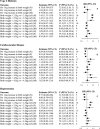Birth Weight and Risk of Type 2 Diabetes Mellitus, Cardiovascular Disease, and Hypertension in Adults: A Meta-Analysis of 7 646 267 Participants From 135 Studies
- PMID: 30486715
- PMCID: PMC6405546
- DOI: 10.1161/JAHA.118.008870
Birth Weight and Risk of Type 2 Diabetes Mellitus, Cardiovascular Disease, and Hypertension in Adults: A Meta-Analysis of 7 646 267 Participants From 135 Studies
Abstract
Background Low birth weight has been associated with increased risk of type 2 diabetes mellitus, cardiovascular disease, and hypertension, but the risk at high birth weight levels remains uncertain. This systematic review and meta-analysis aimed to clarify the shape of associations between birth weight and aforementioned diseases in adults and assessed sex-specific risks. Methods and Results We systematically searched PubMed, EMBASE , and Web of Science for studies published between 1980 and October 2016. Studies of birth weight and type 2 diabetes mellitus (T2 DM ), cardiovascular disease ( CVD ), and hypertension were included. Random-effects models were used to derive the summary relative risks and corresponding 95% confidence intervals.We identified 49 studies with 4 053 367 participants assessing the association between birth weight and T2 DM , 33 studies with 5 949 477 participants for CVD , and 53 studies with 4 335 149 participants for hypertension and high blood pressure. Sex-specific binary analyses showed that only females had an increased risk of T2 DM and CVD at the upper tail of the birth weight distribution. While categorical analyses of 6 birth weight groups and dose-response analyses showed J-shaped associations of birth weight with T2 DM and CVD , the association was inverse with hypertension. The lowest risks for T2 DM , CVD , and hypertension were observed at 3.5 to 4.0, 4.0 to 4.5, and 4.0 to 4.5 kg, respectively. Conclusions These findings indicate that birth weight is associated with risk of T2 DM and CVD in a J-shaped manner and that this is more pronounced among females.
Keywords: birth weight; cardiovascular disease; hypertension; type 2 diabetes mellitus.
Figures




References
-
- Yach D, Hawkes C, Gould C, Hofman KJ. The global burden of chronic diseases: overcoming impediments to prevention and control. JAMA. 2004;291:2616–2622. - PubMed
-
- Ferrie JE, Langenberg C, Shipley MJ, Marmot MG. Birth weight, components of height and coronary heart disease: evidence from the Whitehall II study. Int J Epidemiol. 2006;35:1532–1542. - PubMed
-
- Eriksson J, Forsen T, Tuomilehto J, Osmond C, Barker D. Fetal and childhood growth and hypertension in adult life. Hypertension. 2000;36:790–794. - PubMed
-
- Tamakoshi K, Yatsuya H, Wada K, Matsushita K, Otsuka R, Yang PO, Sugiura K, Hotta Y, Mitsuhashi H, Kondo T, Toyoshima H. Birth weight and adult hypertension: cross‐sectional study in a Japanese workplace population. Circ J. 2006;70:262–267. - PubMed
-
- Carlsson S, Persson PG, Alvarsson M, Efendic S, Norman A, Svanstrom L, Ostenson CG, Grill V. Low birth weight, family history of diabetes, and glucose intolerance in Swedish middle‐aged men. Diabetes Care. 1999;22:1043–1047. - PubMed
Publication types
MeSH terms
LinkOut - more resources
Full Text Sources
Medical

